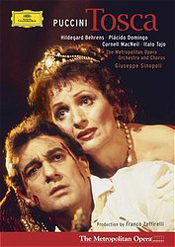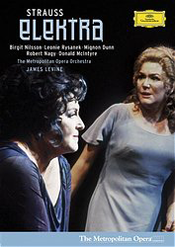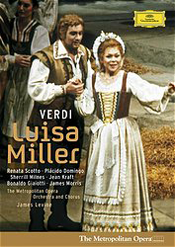
04 Apr 2007
The Metropolitan Opera on DVD: Elektra, Luisa Miller and Tosca
With some deliberation the Metropolitan Opera releases DVD versions of live television broadcasts from its heyday as a PBS mainstay.
The Sixteen continues its exploration of Henry Purcell’s Welcome Songs for Charles II. As with Robert King’s pioneering Purcell series begun over thirty years ago for Hyperion, Harry Christophers is recording two Welcome Songs per disc.
In February this year, Albanian soprano Ermonela Jaho made a highly lauded debut recital at Wigmore Hall - a concert which both celebrated Opera Rara’s 50th anniversary and honoured the career of the Italian soprano Rosina Storchio (1872-1945), the star of verismo who created the title roles in Leoncavallo’s La bohème and Zazà, Mascagni’s Lodoletta and Puccini’s Madama Butterfly.
Collapsology. Or, perhaps we should use the French word ‘Collapsologie’ because this is a transdisciplinary idea pretty much advocated by a series of French theorists - and apparently, mostly French theorists. It in essence focuses on the imminent collapse of modern society and all its layers - a series of escalating crises on a global scale: environmental, economic, geopolitical, governmental; the list is extensive.
Amongst an avalanche of new Mahler recordings appearing at the moment (Das Lied von der Erde seems to be the most favoured, with three) this 1991 Mahler Second from the 2nd Kassel MahlerFest is one of the more interesting releases.
If there is one myth, it seems believed by some people today, that probably needs shattering it is that post-war recordings or performances of Wagner operas were always of exceptional quality. This 1949 Hamburg Tristan und Isolde is one of those recordings - though quite who is to blame for its many problems takes quite some unearthing.
The voices of six women composers are celebrated by baritone Jeremy Huw Williams and soprano Yunah Lee on this characteristically ambitious and valuable release by Lontano Records Ltd (Lorelt).
As Paul Spicer, conductor of the Royal Birmingham Conservatoire Chamber Choir, observes, the worship of the Blessed Virgin Mary is as ‘old as Christianity itself’, and programmes devoted to settings of texts which venerate the Virgin Mary are commonplace.
Ethel Smyth’s last large-scale work, written in 1930 by the then 72-year-old composer who was increasingly afflicted and depressed by her worsening deafness, was The Prison – a ‘symphony’ for soprano and bass-baritone soloists, chorus and orchestra.
‘Hamilton Harty is Irish to the core, but he is not a musical nationalist.’
‘After silence, that which comes closest to expressing the inexpressible is music.’ Aldous Huxley’s words have inspired VOCES8’s new disc, After Silence, a ‘double album in four chapters’ which marks the ensemble’s 15th anniversary.
A song-cycle is a narrative, a journey, not necessarily literal or linear, but one which carries performer and listener through time and across an emotional terrain. Through complement and contrast, poetry and music crystallise diverse sentiments and somehow cohere variability into an aesthetic unity.
One of the nicest things about being lucky enough to enjoy opera, music and theatre, week in week out, in London’s fringe theatres, music conservatoires, and international concert halls and opera houses, is the opportunity to encounter striking performances by young talented musicians and then watch with pleasure as they fulfil those sparks of promise.
“It’s forbidden, and where’s the art in that?”
Dublin-born John F. Larchet (1884-1967) might well be described as the father of post-Independence Irish music, given the immense influenced that he had upon Irish musical life during the first half of the 20th century - as a composer, musician, administrator and teacher.
The English Civil War is raging. The daughter of a Puritan aristocrat has fallen in love with the son of a Royalist supporter of the House of Stuart. Will love triumph over political expediency and religious dogma?
Beethoven Symphony no 9 (the Choral Symphony) in D minor, Op. 125, and the Choral Fantasy in C minor, Op. 80 with soloist Kristian Bezuidenhout, Pablo Heras-Casado conducting the Freiburger Barockorchester, new from Harmonia Mundi.
A Louise Brooks look-a-like, in bobbed black wig and floor-sweeping leather trench-coat, cheeks purple-rouged and eyes shadowed in black, Barbara Hannigan issues taut gestures which elicit fire-cracker punch from the Mahler Chamber Orchestra.
‘Signor Piatti in a fantasia on themes from Beatrice di Tenda had also his triumph. Difficulties, declared to be insuperable, were vanquished by him with consummate skill and precision. He certainly is amazing, his tone magnificent, and his style excellent. His resources appear to be inexhaustible; and altogether for variety, it is the greatest specimen of violoncello playing that has been heard in this country.’
Baritone Roderick Williams seems to have been a pretty constant ‘companion’, on my laptop screen and through my stereo speakers, during the past few ‘lock-down’ months.
Melodramas can be a difficult genre for composers. Before Richard Strauss’s Enoch Arden the concept of the melodrama was its compact size – Weber’s Wolf’s Glen scene in Der Freischütz, Georg Benda’s Ariadne auf Naxos and Medea or even Leonore’s grave scene in Beethoven’s Fidelio.

With some deliberation the Metropolitan Opera releases DVD versions of live television broadcasts from its heyday as a PBS mainstay.
Those years have long since past, though Peter Gelb has managed to revive much interest with the innovation of the relays to movie theaters. Each of the three DVDs of concern here feels like “event” television: a rare Verdi opera featuring three of the Met’s biggest stars of the time (Scotto, Domingo, and Milnes in Luisa Miller); a new Zefferelli Tosca; and Birgit Nilsson’s return, in a full staging of Elektra, after years of absence from Lincoln Center.

Ranging from January 1979 for the Verdi to March 1985 for the Puccini, all three DVDs show the Met at its traditional best, with elaborate sets often greeted by audience applause, charismatic stars, and the highly professional support of the Met orchestra (under James Levine for the Verdi and Strauss, with Giuseppe Sinopoli leading Tosca). The DVDs boast bonus features that actually supplement the viewing experience. The Verdi and Puccini have photo galleries that present fascinating information on each opera’s performance history, as well as interview segments apparently seen at intermission time during the broadcasts. No great insights are produced in these talks, but there’s always a fascination in seeing the performers in street clothes, so very different from the characters they have just been seen as. The Tosca also features a 20-minute walking tour of Rome with Zefferelli and a note-taking assistant (yes, a comely young man). The three locales of Tosca’s action are viewed, and Zefferelli occasionally says something of real interest. Ostensibly he wanted his Scarpia to be dangerously attractive to Floria — in the event, Cornell MacNeil is not able to pull this off. But the psychology behind Zefferelli’s insight remains viable. He also offers what amounts to almost his entire artistic philosophy: “Opera is essential! Opera cannot be sophisticated.”
Ultimately the performance counts above all else. Purely as singing, the Luisa Miller has the greatest success of the three. Renata Scotto triumphs as Verdi’s Luisa, a heroine whose trajectory of happiness to misery parallels Violetta’s, though without the depth and social impact of Traviata. Domingo is Domingo, singing handsomely and furrowing his brow with maximum exertion. Sherill Milnes manages the tricky feat of keeping Miller an appealing father figure as his character becomes a pawn to the tangled plot’s manipulations. As Wurm, James Morris reveals the talent that would soon move him into larger roles.

The booklet essay focuses on Scotto; that’s understandable but preferable would be some comment on why the set, so traditional as to be almost laughable in its faux-Swiss kitsch, apparently features fake balcony boxes at the sides, populated with well-dressed supers. That touch of “regie-theater” makes no sense here. And neither does Domingo’s blond wig.
The Elektra disc serves as a tribute to Birgit Nilsson at the Met. The bonus features include her touching paean to Levine at his 25th anniversary gala, and her contributions to the centennial gala. Most fascinating is almost 20 minutes of backstage footage during the curtain calls for the Elektra. Cutting back and forth between the ecstatic reception out front and the genial camaraderie in the cramped area between curtain and set, this footage makes fascinating viewing, even if just to hear Birgit announce “I need a drink.”
While praising the performance, booklet essay writer J. F. Mastroianni acknowledges it “may not be flawless,” noting the “occasional pitch concern.” For your reviewer, Elektra’s opening monologue is pretty much a lost cause, and though Nilsson gradually finds a way to stabilize her vocal production, it is sheer charismatic energy that pulls her through. For acting she doesn’t do much more than raise her fists to heaven, but the fierceness of her spirit still comes through. And when Nilsson tussles with Leonie Rysanek’s Chrysothemis, the hallowed images of Bette Davis and Joan Crawford come to mind. In securer voice than those two leads, Mignon Dunn’s Klytämenstra and Donald McIntyre’s Orest still find themselves in the shadow of Nilsson and Rysanek’s dramatic conviction.
For the Met, Herbert Graf’s production (with sets and costumes by Rudolf Heinrich) appears almost modern, with its abstract, timeless space and minimal use of props. Levine’s reading of the score maintains a firm grasp of its rigor while embracing the very few moments of lyricism. As described above, Zefferelli’s Tosca, new for this 1985 filming, favors huge spaces, elaborately detailed, as well as the frequent use of extras, most of whom have some distracting bit of business. The best example here comes in act three, when two handsome hunks cross the stage, one with shirt wide-open to expose a gym-generated chest. They are carrying cleaning equipment, as if they are janitorial staff, and one lays down to enjoy the shepherd’s song, after which they both saunter off-stage. The auditions for these two roles must have been extensive and exhausting.
Tosca gets performed so often, at least in the USA, because the tight construction and supremely dramatic score almost guarantee a satisfied audience, even if the singing doesn’t compete with the best performances. Such is the case here. The great Cornell MacNeil is caught late, and though he knows the role and provides a worthy reading, the voice is rough-edged where Scarpia’s calls for oily smoothness. As contrast, Domingo is in fine voice and uses his manly persona well enough. What essential difference there is between his Cavaradossi and his Rodolfo mentioned above eludes your reviewer.
Hildegard Behrens was enjoying the prime of her career, and few dramatic sopranos will pass up a chance at Floria Tosca. As acting, Behrens does probably as good a job as anyone. The voice is simply not rich enough to provide the lyricism that Tosca relishes as much as she does hysteria. Only in Tosca’s final tragic declaration, “Avanti a dio!” does Behrens find a line that requires the edgy power she brought to Wagner. But she barks out some truly scary cries of “mori!” as Scarpia kicks the bucket.
While Italo Tajo’s Sacristan is hammy, Anthony Laciura gives a classically unctuous Spoletta. Sinopoli rushes at times but his energy brings a needed sense of risk to the evening.
As time passes a gentle coat of dust seems to be falling over much of the Metropolitan’s filmed heritage, but then again, what seems so fresh and exciting in today’s productions will have to face the test of time as well. For those eager to a trip back to Reagan-era opera, Met style, any or all of these three DVDs are just the thing.
Chris Mullins